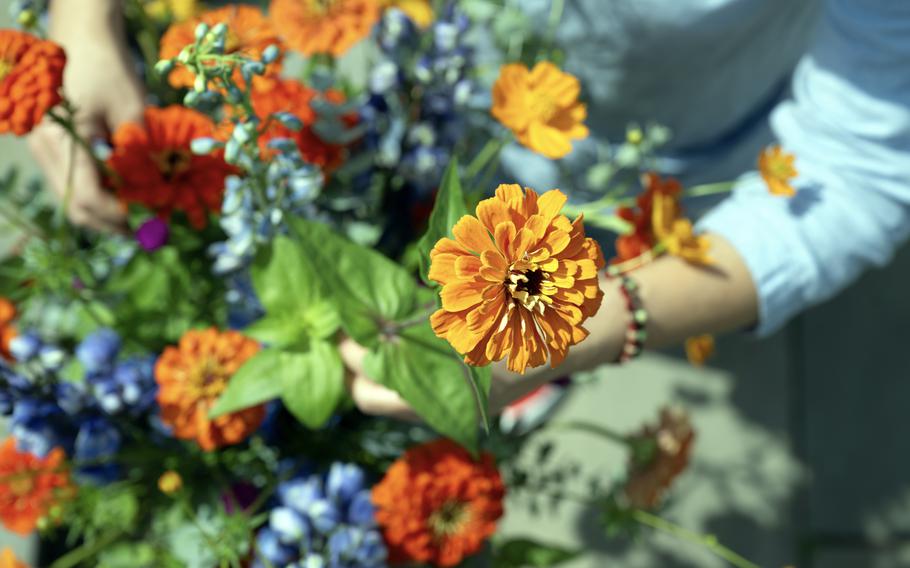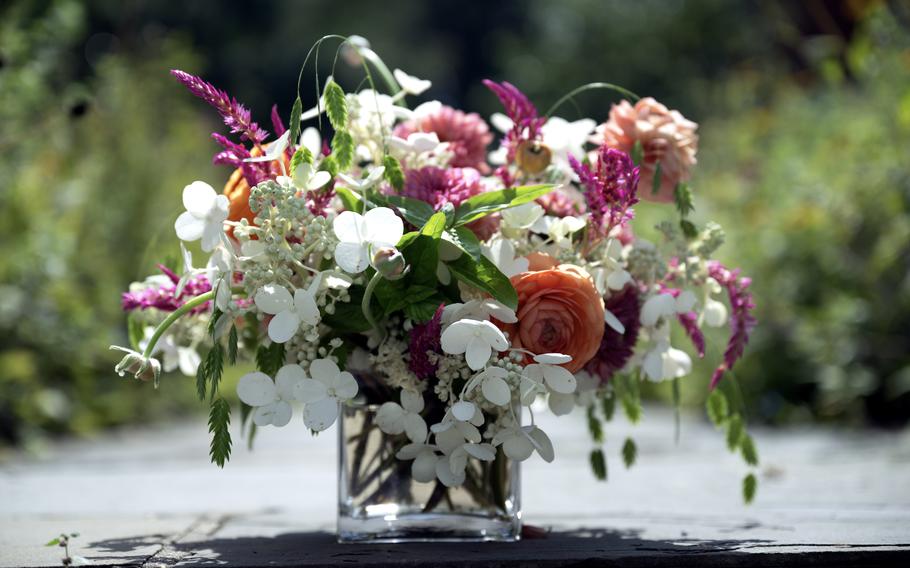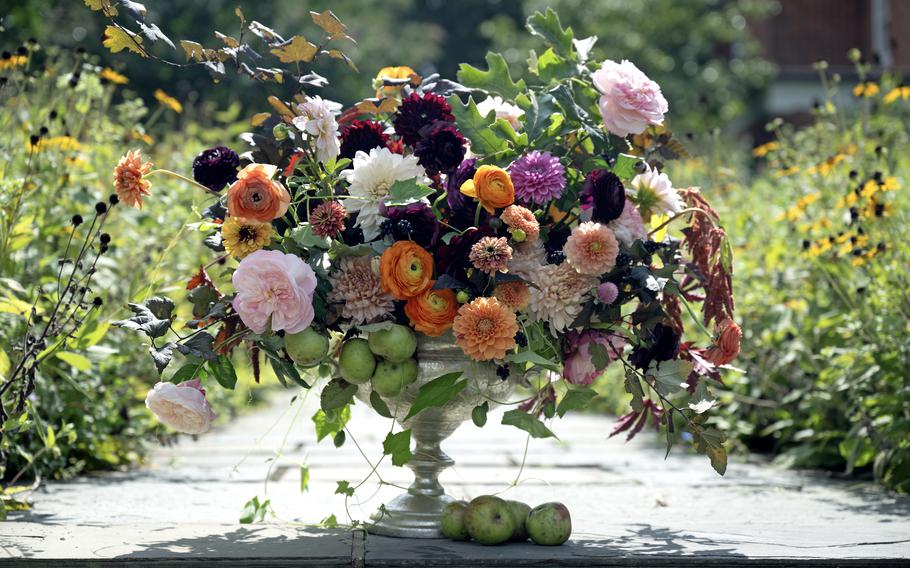
You can create artful, professional-looking arrangements at home — no experience necessary. (Marvin Joseph/The Washington Post)
Most of the time, DIY floral arranging involves bringing home a bouquet or two of cut flowers, depositing them in a generic glass vase scrounged from under the sink and then wondering why they look a bit ... off. But it doesn’t have to be this way.
Part of the skill of flower arranging is matching the blooms to the vessel, so we presented floral designers with three types of containers to get their foolproof tips on how to create artful, professional-looking arrangements at home — no experience necessary.
Here’s what they recommend:

Ami Wilber, floral event decor designer at the Hillwood Museum in Washington, created this short arrangement using dahlias, hydrangeas, ranunculus, celosia, basil and sea oats. (Marvin Joseph/The Washington Post)
Container: Short and squat
Recommended flowers: Hydrangeas, roses, dahlias, carnations, ranunculus, pincushion flowers, sea oats.
Pro tip: Buy twice as many flowers as you think you need.
When it comes to designing an arrangement for a compact vase, more is definitely more.
“If you’re doing a low, tight arrangement, better to have it be full and lush than have it look sparse,” says Ami Wilber, floral event decor designer at the Hillwood Museum in Washington. Plan to buy enough flowers to fill twice the size of the vase opening. “Once you cut them down to size, they often don’t take up as much space as you thought they would,” she says.
To begin any arrangement, use floral shears or sharp scissors to cut the end of each flower at a 45-degree angle, and strip the foliage from the part of the stems that will be submerged in water.
Short stems are less stable, so you may want to add some support to a low arrangement. One easy trick is to tape a grid across the top of the container with clear floral tape or Scotch tape. “It allows you to have an armature for the flowers to slip into, so it holds the shape and style of the design better,” says Rachel Gang of Helen Olivia Floral Design in Alexandria, Va.
Fill the container with water first, then begin the arrangement with one or two “mass flowers.” A mass flower is a single-stem bloom with one large, full head.
Gang likes to start with a hydrangea, or two, because it provides a forgiving base and takes up a lot of real estate in the vase, then she adds roses or dahlias, and smaller flowers such as ranunculus or scabiosa, also known as pincushion flowers.
For a budget-conscious option, Wilber suggests old-school carnations. “I know that some people might have a strong aversion to them, but they lend a nice textural quality to this type of arrangement,” she says.
Grasses, such as sea oats and seeded eucalyptus, can help fill out the arrangement.
“Even if the container is really squat, I still like to have some sort of wispy gesture that comes up from the body of the arrangement to lend it a bit of movement. Just make sure it doesn’t block the view of the people sitting across the table from you,” Wilber says.
Container: Tall and cylindrical
Recommended flowers: Delphiniums, larkspurs, gladioli, sunflowers, lilies, pompon dahlias, cosmos.
Pro tip: To give short stems a boost, fill the bottom of your vase with pebbles or lemons and limes.
Tall arrangements are meant to be showy, and their verticality is a part of their drama.
“My rule of thumb is that the arrangement should be no more than 1 1/2 times the height of the container, and that’s to create stability for the arrangement,” Wilber says. “Anything taller than that and you run the risk of having it not be balanced.”
For a 12-inch vase, the flowers should add no more than 18 inches in height, so the arrangement would be 30 inches tall, measuring from the base of the vessel. If your stems are too short to touch the bottom, Wilber recommends filling the first few inches of your container with pebbles or lemons and limes.
Jeanne Ha, founder and president of Washington Flower School in Takoma Park, Md., likes to start with tall “line flowers” to establish the arrangement’s highest point. “A line flower will have a long, sturdy stem and florets that grow along the stem, such as delphinium, larkspur or gladioli,” she says. Other examples of line flowers include snapdragons, Veronicas and bells of Ireland.
Next, Ha creates “the face” of the arrangement with the main, or focal-point, flowers. These could include any long-stemmed blooms such as sunflowers, lilies, calla lilies and some roses.
For the placement of the main flowers, Wilber likes to think in odd-number increments. “For instance, you could create a triangle with three large focal-point flowers, then fill in that triangle with other blooms, such as pompon dahlias or smaller zinnias,” she says.
Stagger the largest blooms for a more natural look. And don’t forget greenery — Wilber recommends incorporating foliage and grasses for texture and movement. “You want something with a draping quality so the arrangement doesn’t feel too static in the container,” she says.
Or, keep it very simple. If you don’t want to mess with a lot of different blooms, Ha suggests sticking to just one type of line flower, such as a bunch of delphinium, for a classic look.

For a large-scale, lush look, Ami Wilber, floral event decor designer at the Hillwood Museum in Washington, arranged dahlias, ranunculus, zinnias, oak leaf, garden roses, ninebark and apples in a pedestal bowl. Cucumber vine and stems of love lies bleeding lend a romantic draping effect. (Marvin Joseph/The Washington Post)
Container: Pedestal bowl
Recommended flowers: Dahlias, peonies, roses, tulips, ranunculus, eucalyptus.
Pro tip: Adding structural reinforcement, such as floral frog, is usually necessary with this type of container.
No other vessel lends itself to romantic floral arrangements quite like a pedestal bowl, a container that often made appearances in Dutch and Flemish botanical paintings of the 17th century. But the wide-mouthed shape presents a challenge for the home arranger.
“It’s shallow with a very large opening, so mechanics become even more important,” Gang says. For structural reinforcement, use a floral frog or line the inside of the vase with a cushion of chicken wire. For the latter, cut a square of chicken wire and fold it into a pillow or ball shape, twisting any sharp ends inward so they don’t scratch your container. Nestle it into the vase. This should create a framework for stems to slide into easily. Taping a grid over the opening can help, too.
Wilber begins by filling in greenery and branches — which make up the tallest part of the arrangement — to create an architectural skeleton. “I like to green 75% of the arrangement before bringing in flowers,” she says. For foliage, she recommends eucalyptus, ruscus, ferns, oak leaf branches or magnolia leaves.
Place larger blooms such as dahlias, peonies or roses near the base of the arrangement — this will create a bit of support for the other flowers. Next, bring in blooms with some movement or curve to the stem, such as tulips or ranunculus.
Wilber is especially fond of the larger Cloony ranunculus. “If you think of the Dutch Masters, they painted lilies, tulips, roses, that sort of thing, so you can let that theme guide you,” she says. Finally, artful imperfection is the key to this look, so incorporate an element that seems loose or off-kilter, such as a wayward tendril or a cascading vine.
For the palette, Wilber likes working with contrasting colors, such as blues and oranges, because it makes for a more dynamic arrangement.
Gang prefers to stick to hues that neighbor each other on the color wheel — for example, a citrusy palette of coral, orange and peach. If you opt to go monochrome, incorporate different tones and textures to keep the arrangement interesting.
And make sure your blooms are properly hydrated. Says Ha, “On the first night after an arrangement is finished, the flowers drink the most, so refill the water to the top the next morning.”